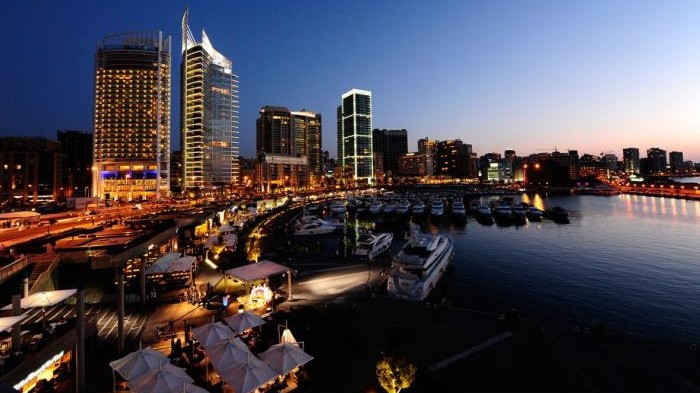where is beirut located

where is beirut located
Beirut, Arabic Bayrūt, French Beyrouth, capital, chief port, and largest city of Lebanon. It is located on the Mediterranean coast at the foot of the Lebanon Mountains
Beirut is a city of baffling contradictions whose character blends the sophisticated and cosmopolitan with the provincial and parochial. Before 1975 Beirut was widely considered the most thoroughly Westernized city in the Arab Middle East; after that, however, 15 years of civil war ravaged most parts of the city and eroded much of the lustre that had formerly concealed the Arab—as distinct from the Levantine—side of its character. Despite the sectarian and ideological passions unleashed by the civil war, Beirut retains its basically liberal and tolerant way of life, albeit in changed circumstances. In the 1990s Beirut began extensive rebuilding efforts to restore its economic base and cultural landmarks. Area governorate, 7 square miles (18 square km); city, 26 square miles (67 square km). Pop. (2003 est.) city, 1,171,00; (2005 est.) urban agglom., 1,777,000
City site
The city sits atop two hills, al-Ashrafiyyah (East Beirut) and al-Muṣayṭibah (West Beirut), that protrude into the sea as a roughly triangular peninsula. In the immediate hinterland lies a narrow coastal plain (Al-Sāḥil) that extends from the mouth of the Nahr al-Kalb (Dog River) in the north to that of the Nahr al-Dāmūr (Damur River) in the south
Climate
Beirut has a subtropical climate that is cool and temperate in winter and hot and humid in summer. In January, the coolest month, the average afternoon maximum temperature is 62 °F (17 °C), and the nighttime low is 51 °F (11 °C). Comparable maximum and minimum temperatures in July are 87 and 73 °F (31 and 23 °C). The rainy season extends from mid-autumn to early spring, and the average annual rainfall is 36 inches (914 mm)
City layout
Under the Ottoman vilāyet administration and the French mandate, the growth of Beirut was planned, but after independence in 1943 it was as haphazard as it was rapid. It is estimated that the population of the city increased 10-fold between the early 1930s and early 1970s, and the city’s area grew to three times the size it had been in 1900. By the 1950s few traces of the old city were left, and most of those were destroyed in the 1975–90 civil war.
Street plans and block arrangements in the city and its suburbs are not consistent or uniform. In most quarters, modern high-rise buildings, walk-up apartments, slum tenements, modern villas, and traditional two-story houses with red-tiled roofs—all in varying states of repair—stand side by side. After 1975 countless houses and apartments, particularly in West Beirut, were forcibly occupied by refugees and squatters from rural areas, especially from the Shiʿi areas of southern Lebanon
The downtown area of central Beirut (the old city) was destroyed during the civil war, becoming a belt of squatter-occupied ruins between East and West Beirut. Because of the sporadic fighting that occurred between rival factions, central Beirut could not be reconstructed during the war, and all business moved out of the area to establish new premises in the Christian and Muslim sides of the city. When the war ended in 1990, strong divisions arose between official and popular opinion over plans for reconstructing the old city. Standing property rights, which were largely in the hands of Sunni Muslim and Christian landowners, clashed with the then de facto situation that most of the resident squatters in the area were Shiʿi Muslims. Progress in the direction of reconstruction in the 1990s was thus slow-coming. A combination of payoffs and eminent domain cleared the way for the rapid development of the Beirut Central District (BCD) in the first decade of the 21st century. Investment slowed in the 2010s, however, amid instability in the region
People
According to the government, the resident population of Beirut is more or less evenly divided between Muslims and Christians. In the absence of reliable statistics, however, this official supposition has never been possible to verify. The influx of large numbers of Shiʿis into West and central Beirut during the civil war probably tipped the population balance in favour of the Muslims. The overwhelming majority in both religious groups—Christians and Muslims—is ethnically Arab and includes Palestinian refugees, Syrian residents, and others. The most important ethnic minority is the Christian Armenians; there is also a Kurdish ethnic minority among the Muslims. East Beirut is almost solidly Christian, West Beirut is predominantly Muslim, and a number of mixed neighbourhoods (notably in the district of Raʾs Bayrūt) are cosmopolitan in character. The small Jewish community, once concentrated in the downtown neighbourhood of Wādī Abū Jamīl, was reduced further by emigration during the war. Most of those who remained have shifted their residence to East Beirut and adjacent Christian suburbs. The larger Christian communities are the Maronites and the Greek Orthodox; the Christian minorities, apart from the Armenians, include Greek Catholics, Protestants, Roman Catholics, and others. Originally, the Sunnis were the dominant Muslim community, but Shiʿi Muslims began moving into the city in increasing numbers in the 1960s
